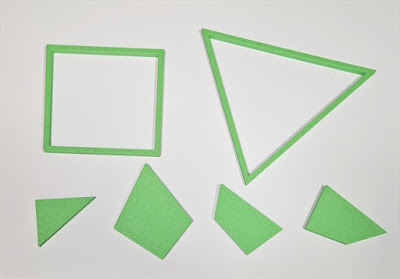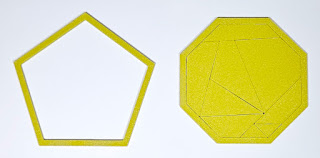3D-Printable Regular Polygon Dissection Puzzles
I've been busy prototyping mathematical toys this year and have had several parents ask me where they can be purchased. I can't really scale my 3D printing in a way that makes sense, so I'll try looking into injection molding or laser cutting when I've got time. In the meantime, my intention was already to make my 3D printing files publicly available, so I'll start with some geometric dissection puzzles.
Puzzles
Each of these puzzles is a dissection that can be assembled into one of two regular polygons. Most of them can be found on Gavin Theobald's website, which is a treasure trove of dissections — many of which Gavin discovered himself!
Along with the dissection puzzle pieces, I've also created frames to make assembly easier. I'll mention some other use cases later, but I'll present these as they were originally intended: a puzzle and its two frames, with each puzzle color-coded so that I can store them all in one bin.
3-4: Triangle/Square
3-5: Triangle/Pentagon
3-6: Triangle/Hexagon
3-8: Triangle/Octagon
4-5: Square/Pentagon
4-6: Square/Hexagon
4-7: Square/Heptagon
4-8: Square/Octagon
4-9: Square/Nonagon
4-10: Square/Decagon
4-11: Square/Hendecagon
4-12: Square/Dodecagon
5-6: Pentagon/Hexagon
5-8: Pentagon/Octagon
6-8: Hexagon/Octagon
6-12: Hexagon/Dodecagon
Files
The file dissection_puzzles.zip contains two folders. One contains STL files, which most 3D printer software should accept. A file named dissection_M-N.stl contains the puzzle pieces and both frames for a dissection between a regular M-gon and a regular N-gon.
The other folder contains SCAD files, which can be opened with the free program OpenSCAD. These are included in case you want to do anything more sophisticated than printing the puzzles as they are formatted in the STL files. The main things you'd likely want to edit are in the dissection_methods.scad file, which all of the other files import. It contains the dimensional parameters, which I'll describe, giving their default values in millimeters:
\(s = 72\): If one of the dissection's polygons is a square, this is its side length without a frame. Otherwise, intepret this as the side length of a square with the same area as the polygons in the dissection.
\(h = 4\): The height (thickness) of the puzzle pieces and frame.
\(b = 4\): The width of the frame's border. For example, if \(b = 4\) and \(s = 72\), since \(4+72+4 = 80\), a completed square dissection puzzle with frame will be \(80\) mm by \(80\) mm.
\(t = 0.05\): The tolerancing gap between pieces. It is shaved off each piece, leaving a gap of width \(2t\).
If you intend to scale up or scale down the puzzles, doing so with the STL files in your 3D printing software will scale the tolerancing gaps accordingly, making fits looser or tighter. You may want to instead alter the SCAD file by changing \(s\), \(h\), and \(b\) but leaving \(t\) alone. On the other hand, if you feel my tolerancing was already too loose or tight for your taste, you might try tweaking \(t\).
The SCAD files are also useful for things like printing out individual pieces of a dissection instead of all pieces at once. You can do this by commenting out all lines of the form
translate(coords)polygon_piece(piece)
except for your desired piece. For example, To get only the large piece of the triangle to square dissection, you would add slashes like so:
//translate([0,q,0])polygon_piece(P1);
//translate([q,q,0])polygon_piece(P2);
//translate([0,0,0])polygon_piece(P3);
translate([q,0,0])polygon_piece(P4);
Then you would render via [Design] > [Render] and export via [File] > [Export] > [Export as STL...] or [File] > [Export] > [Export as 3MF...].
Presentation Options
There are a few ways that you might present these puzzles, which will change how you want print them.
As presented above: The way that I've presented my puzzles is as a set of pieces that can be assembled in either of two frames. This required printing the two associated frames per dissection in the same color as those pieces and used different colors for different puzzles. I found this to be a good way to present the puzzle to young learners, since they identify them as puzzles with little or no direction and associate pieces with frames by color.
Unique frames (easy): Pick a color for each polygon (triangle, square, pentagon, etc.) and print the frames in those respective colors. Then print the pieces for a dissection of an \(m\)-gon to \(n\)-gon in both polygons' colors. (Your printer software might have the option to assign different colors, but this could also be done by printing halfway in one color, pausing the printer, swapping to a second color, and resuming the job.) This will give solvers a way to associate pieces to a frame in a way that will easily accommodate future puzzles without ballooning the number of colors.
Unique frames (hard): Print each set of dissection puzzle pieces in a different color and then print all of the frames in the same new color. Without color clues, the solvers will first have to decide which frames could be associated with a given dissection puzzle. In practice, this will likely work as a frame-free assembly followed by fitting a frame around a finished puzzle.
Frameless: Print only the dissection puzzle pieces without the frames. You can either present the pieces alongside which polygons they form or leave that up to the solver. These puzzles are much harder without being able to use a frame as a guide, even knowing the shape they're supposed to make.
I'm sure there are plenty of other ways to present these, but my preference throughout has been that one dissection puzzle's pieces should be readily discernible from another puzzle's pieces, whether it be via coloration, texture, or some other system.
Regular Polygon Dissection Puzzles by Nick Rauh is licensed under CC BY-NC-SA 4.0
 |  |
















































Comments
Post a Comment